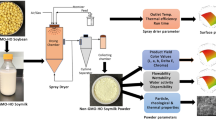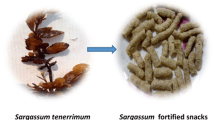Abstract
The aim of this study was to find the optimum extrusion process conditions for texturized soybean meal as a meat analogue for food formulations using genetic algorithm. The defatted soybean meal was replaced with whole soybean meal at 10% and extruded in the temperature range of 150–200 °C, screw speed of 270–300 rpm and 20–25% feed moisture content based on the Box–Behnken design. The barrel temperature effect was markedly greater than those of the feed moisture content and screw speed on the product functional properties and appearance. Higher temperatures led to a higher rehydration capacity, water and oil absorption capacity, however, it had a negative effect on the product brightness. It was found that the extrusion at lower moisture content improved soy protein functionality. Genetic algorithm technique was applied to find the best process conditions. The optimized process conditions were found to be the temperature of 198.8 °C, screw speed of 291 rpm and feed moisture content of 20.2%. Overall, the whole soybean treatment was applicable to overcome the oil separation issue during extrusion and the process was optimized to produce texturized soy protein with the maximum attainable functionality.






Similar content being viewed by others
References
AACC (2000) Approved methods of the American Association of Cereal Chemists. Method 56-20: hydration capacity of pregelatinized cereal products. American Association of Cereal Chemists, St Paul
Bookwalter GN, Mustakas GC, Kwolek WF, McGhee JE, Albrecht WJ (1971) Full-fat soy flour extrusion cooked: properties and food uses. J Food Sci 36:5–9. doi:10.1111/j.1365-2621.1971.tb02019.x
Camire M (1991) Protein functionality modification by extrusion cooking. J Am Oil Chem Soc 68:200–205. doi:10.1007/bf02657770
Chen W, Wang W-P, Zhang H-S, Huang Q (2012) Optimization of ultrasonic-assisted extraction of water-soluble polysaccharides from Boletus edulis mycelia using response surface methodology. Carbohydrate Polymers 87:614–619. doi:10.1016/j.carbpol.2011.08.029
Chen FL, Wei YM, Zhang B, Ojokoh AO (2010) System parameters and product properties response of soybean protein extruded at wide moisture range. J Food Eng 96:208–213. doi:10.1016/j.jfoodeng.2009.07.014
Crowe T, Johnson L (2001) Twin-screw extrusion texturization of extruded-expelled soybean flour. J Am Oil Chem Soc 78:781–786. doi:10.1007/s11746-001-0342-8
Edward Doe P, Barbara Cybulska E (2006) Water and food quality. In: Sikorski ZE (eds) Chemical and functional properties of food components, 3rd edn. Chemical and Functional Properties of Food Components. CRC Press, pp 29–60. doi:10.1201/9781420009613.ch3
Fathi M, Mohebbi M, Razavi SMA (2010) Genetic algorithm optimization of drying conditions of kiwifruit. In: 17th international drying symposium (IDS), Magdeburg, pp 1437–1440
Garg S, Singh D (2010) Optimization of extrusion conditions for defatted soy-rice blend extrudates. J Food Sci Technol 47:606–612. doi:10.1007/s13197-010-0117-y
Guerrero P, Beatty E, Kerry JP, de la Caba K (2012) Extrusion of soy protein with gelatin and sugars at low moisture content. J Food Eng 110:53–59. doi:10.1016/j.jfoodeng.2011.12.009
Gujska E, Khan K (1990) Effect of temperature on properties of extrudates from high starch fractions of navy, pinto and garbanzo beans. J Food Sci 55:466–469. doi:10.1111/j.1365-2621.1990.tb06788.x
Hager DF (1984) Effects of extrusion upon soy concentrate solubility. J Agric Food Chem 32:293–296. doi:10.1021/jf00122a029
Jao YC, Chen AH, Lewandowski D, Irwin WE (1978) Engineering analysis of soy dough rheology in extrusion. J Food Process Eng 2:97–112. doi:10.1111/j.1745-4530.1978.tb00197.x
Joshi SMR, Bera MB, Panesar PS (2012) Extrusion cooking of maize/spirulina mixture: factors affecting expanded product characteristics and sensory quality. J Food Process Preserv 38:655–664. doi:10.1111/jfpp.12015
Koc AB, Heinemann PH, Ziegler GR (2007) Optimization of whole milk powder processing variables with neural networks and genetic algorithms. Food Bioprod Process 85:336–343. doi:10.1205/fbp07074
Lazou A, Krokida M (2010) Functional properties of corn and corn–lentil extrudates. Food Res Int 43:609–616. doi:10.1016/j.foodres.2009.09.017
Lin MJY, Humbert ES, Sosulski FW (1974) certain functional properties of sunflower meal products. J Food Sci 39:368–370. doi:10.1111/j.1365-2621.1974.tb02896.x
Lusas E (1996) Modern texturized soy proteins: preparation and uses. Food Technol 50:132–135
Mohebbi M, Shahidi F, Fathi M, Ehtiati A, Noshad M (2011) Prediction of moisture content in pre-osmosed and ultrasounded dried banana using genetic algorithm and neural network. Food Bioprod Process 89:362–366. doi:10.1016/j.fbp.2010.08.001
Nelson AI, Leigh JS (1983) Extrusion texturization of full-fat soybean and product thereof. U.S. Patent No. 4,369,195. 18 Jan
Osen R, Toelstede S, Wild F, Eisner P, Schweiggert-Weisz U (2014) High moisture extrusion cooking of pea protein isolates: raw material characteristics, extruder responses, and texture properties. J Food Eng 127:67–74. doi:10.1016/j.jfoodeng.2013.11.023
Prudencio-Ferreira SH, Areas JG (1993) Protein–protein interactions in the extrusion of soya at various temperatures and moisture contents. J Food Sci 58:378–381. doi:10.1111/j.1365-2621.1993.tb04279.x
Rueda J, Kil-Chang Y, Martínez-Bustos F (2004) Functional characteristics of texturized defatted soy flour. Agrociencia 38:63–73
Shankar TJ, Bandyopadhyay S (2004) Featuring tissue engineering optimization of extrusion process variables using a genetic algorithm. Food Bioprod Process 82:143–150. doi:10.1205/0960308041614855
Shankar TJ, Sokhansanj S, Bandyopadhyay S, Bawa AS (2010) A case study on optimization of biomass flow during single-screw extrusion cooking using genetic algorithm (GA) and response surface method (RSM). Food Bioprocess Technol 3:498–510. doi:10.1007/s11947-008-0172-9
Singh RKR, Majumdar R, Venkateshwarlu G (2012) Optimum extrusion-cooking conditions for improving physical properties of fish-cereal based snacks by response surface methodology. J Food Sci Technol 51:1827–1836. doi:10.1007/s13197-012-0725-9
Singh JP, Kaur A, Shevkani K, Singh N, Singh B (2016) Physicochemical characterisation of corn extrudates prepared with varying levels of beetroot (Beta vulgaris) at different extrusion temperatures. Int J Food Sci Technol 51:911–919. doi:10.1111/ijfs.13051
Sorgentini DA, Wagner JR, Arrese EL, Anon MC (1991) Water imbibing capacity of soy protein isolates: influence of protein denaturation. J Agric Food Chem 39:1386–1391. doi:10.1021/jf00008a006
Thymi S, Krokida MK, Pappa A, Maroulis ZB (2005) Structural properties of extruded corn starch. J Food Eng 68:519–526. doi:10.1016/j.jfoodeng.2004.07.002
Tovar-Jiménez X et al (2015) Third generation snacks manufactured from orange by-products: physicochemical and nutritional characterization. J Food Sci Technol 52:6607–6614. doi:10.1007/s13197-015-1726-2
Wang C, Johnson LA (2001) Functional properties of hydrothermally cooked soy protein products. J Am Oil Chem Soc 78:189–195. doi:10.1007/s11746-001-0242-y
Yu L (2011) Extrusion processing of protein rich food formulations. McGill University Libraries, Montreal
Yu L, Ramaswamy H, Boye J (2012) Twin-screw extrusion of corn flour and soy protein isolate (spi) blends: a response surface analysis. Food Bioprocess Technol 5:485–497. doi:10.1007/s11947-009-0294-8
Yu L, Ramaswamy HS, Boye J (2013) Protein rich extruded products prepared from soy protein isolate–corn flour blends. LWT Food Sci Technol 50:279–289. doi:10.1016/j.lwt.2012.05.012
Author information
Authors and Affiliations
Corresponding author
Electronic supplementary material
Below is the link to the electronic supplementary material.
Rights and permissions
About this article
Cite this article
Mazaheri Tehrani, M., Ehtiati, A. & Sharifi Azghandi, S. Application of genetic algorithm to optimize extrusion condition for soy-based meat analogue texturization. J Food Sci Technol 54, 1119–1125 (2017). https://doi.org/10.1007/s13197-017-2524-9
Revised:
Accepted:
Published:
Issue Date:
DOI: https://doi.org/10.1007/s13197-017-2524-9




